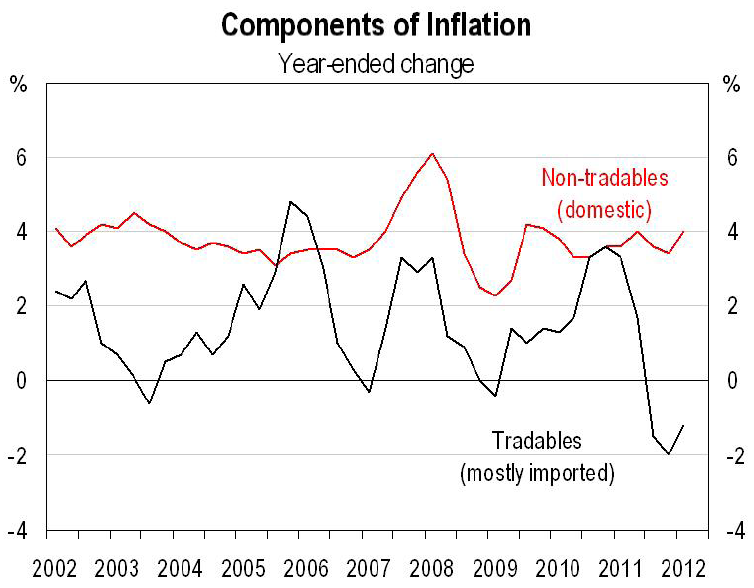Late yesterday, HSBC’s Paul Bloxham released a note that continues his recent good work on Dutch disease. In the note he declares that Australia’s Dutch disease has arrived. No, he is not talking about “hollowing out”, which he repudiates, he means a structural shift to higher inflation owing to falling productivity:
the free gift of rising commodity prices – they have increased in 9 of the past 10 years – meant a weakening of the local reform agenda, slowing productivity growth. Productivity growth has been weak, albeit improving a little recently. Over the past six years, GDP per hour worked (labour productivity) has grown by 1% a year, half its pace of the previous five years.
Without solid productivity growth, Australia’s economy could see lower potential growth rates. This problem has been somewhat hidden by the free kick to incomes from rising commodity prices over recent years. When income growth is supported by a free gift, there is less incentive to reform. At the same time, the rise in the AUD – in response to higher commodity prices – has held back Australian inflation, despite rising domestic costs.
Not wrong, for sure. But I would describe things a little differently.
I am not worried about inflation yet and here is why. As the terms of trade continue to correct over the next few years, and mining starts to detract from growth mid next year, the income flows that Bloxham describes are going to fall. Bloxham is supremely confident in the RBA’s ability to offset this by lowering interest rates:
We remain optimistic about the non-mining economy’s ability to pick up. The RBA’s cash rate is a powerful tool and the parts of the economy that need to improve are typically interest rate sensitive. The financial system works in Australia and rate cuts have been largely passed through to lending rates.
We also expect that the effect of the high AUD on the exchange rate sensitive industries will start to wear off fairly soon, even without a significant depreciation. The fact that the mining sector is still expected to provide significant support for the economy out to the middle of next year also gives us some confidence that there will be time for the long lags of monetary policy to work through the economy.
In short, Bloxham like the RBA and Treasury is expecting house prices and construction to fill the income and growth gap. I do not. I see the shift to lower credit demand and higher saving rates as permanent and although we will probably see some uptick in the interest rate sensitive sectors, I expect it to be modest and fleeting.
Moreover, productivity has risen already in the past year. And I expect it to continue to do so as marginal mining projects cease, major new projects start to deliver profits and the remainder of the economy remains in the doldrums and desperate for new ways to make a buck more efficiently. What that adds up to is rising unemployment, which will keep a lid on non-tradable inflation.
You might argue that we’ve seen little evidence of that so far even though unemployment has risen already to 5.4%. Bloxham would probably do so using this chart from his note:

But the recent spike in the red line is misleading. If we were to remove one-off items and carbon-related increases, the little down-trend from 2011 would still be intact. I expect it to stay that way.
As I wrote yesterday, there is a pressing need to re-attach Australian wage increases to productivity growth. But the reason why is not so much an imminent inflation threat as it is a complete loss of Australian competitiveness. As the mining boom passes, therefore, the scope for other parts of the economy to take up the slack is limited. Add in a secular deleveraging impulse and the risks are all to the downside.
We have Dutch disease all right. But barring a big fall in the dollar, it’s not inflation that spooks me, it’s unemployment. Still, it’s important to note that either way, Australian growth rates are past their prime.
121025 Australian Economics Comment – Rising Inflation – A Resources Curse Revealed (1)

